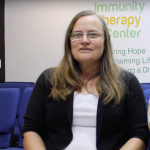Medically Reviewed by: pdm
Our Editorial Policy
Updated on: noviembre 21, 2019
About ovarian cancer
Ovarian cancer is a strain of cancer that is limited to women and occurs in the ovaries of the female reproductive system. Each woman has two ovaries that are like sacs the size of an almond joined by ligaments in the uterus. They are incredibly important for two reproductive functions:
- Fertilization – They produce and release eggs during the menstrual cycle.
- Hormone production – They produce progesterone and estrogen.
According to Healthline, each year: «Approximately 21,000 women in the US will be diagnosed with ovarian cancer. Additionally, approximately 14,000 women in the US will die of this disease in the next year.» Ovarian cancer is most often found in white women over the age of 40, and half of the cases are in women over the age of 63. A woman’s risk of dying from ovarian cancer is about 1 in 108. Typical strains of ovarian cancer include:
- Epithelial tumors: represent 90% of all ovarian cancers. They occur in the thin layer of tissue on the outside of the ovaries.
- Stromal tumors: represent 7% of all ovarian cancers. They start in ovarian tissue that has hormone-producing cells. For that reason, this strain is much more diagnosable in the early stages.
- Germ cell tumors: A rare type of ovarian cancer that occurs in the egg-producing cells of young women.
- Peritoneal cancer: A rare type of cancer that acts and looks like ovarian cancer, since the ovaries and peritoneum are made up of epithelial cells. As a result, they have very similar symptoms and treatments, although it can develop even after the ovaries have been removed.
Causes and risk factors
Although we do not yet know the causes of most ovarian cancers, we do know that there are factors that make a woman more susceptible to developing epithelial tumors. Common risk factors include:
- Older age – Although it can occur at any age, it most commonly occurs in women between the ages of 50 and 60.
- Estrogen Hormone Replacement Therapy – Long-term use and / or large doses of artificial hormones increase the risk of developing ovarian cancer.
- Age when menstruation started or ended – If you start menstruation early or start menopause late, it may increase your risk of developing ovarian cancer.
- Family history: It has been shown that there are genetic inheritance links of the disease.
Early detection, diagnosis, and staging
Unfortunately, early-stage ovarian cancer doesn’t have symptoms often. Even advanced-stage ovarian cancer rarely has symptoms that are not relatively benign. As a result, it can be extremely difficult to detect. Such symptoms can look like:
- Constipation
- Diarrhea
- Feeling full after eating small amounts
- Urinate frequently
- Discomfort in the pelvis
- Swelling in the abdomen
- Weightloss
If you see the signs, common tests your doctor may perform include:
- Pelvic exam – The doctor makes a digital insertion into the vagina and then presses his other hand against the abdomen to feel the pelvic organs.
- Imaging tests – CT scans and ultrasounds of the abdomen and pelvis may be taken to better measure the size, shape, and structure of the ovaries.
- Blood test – A blood test can determine if you have cancer cells in your body. Blood is drawn to test for tumor markers and proteins commonly found in cancer cells of the ovaries.
- Surgery : Sometimes it is necessary to remove one of the ovaries to detect cancer.
Stages of ovarian cancer
There are four stages of ovarian cancer:
- Stage I : The cancer remains in the ovaries and has not yet spread to local or distant organs.
- Stage II – The cancer is in one or both ovaries. It has also spread to the fallopian tubes or uterus.
- Stage III – The cancer is in one or both ovaries. It has spread beyond the pelvic region to the abdominal lining or lymph nodes.
- Stage IV – The cancer has advanced and has metastasized to distant organs.
Next steps:
Immunity Therapy Center uses a variety of alternative cancer treatments to strengthen your immune system while targeting cancer cells directly. The type and combination of therapies we use vary depending on the type and location of the cancer, the stage of the cancer, and the individual’s overall health. If you are interested in a personalized alternative therapy treatment plan or learning more about alternative therapy for cancer treatment, contact the Immunity Therapy Center today!
Sources:
Baber, R. NCBI. Menopausal hormone therapy and ovarian cancer. (2015). https://www.ncbi.nlm.nih.gov/pmc/articles/PMC4604667/
Cancer.org. Ovarian Cancer. https://www.cancer.org/cancer/ovarian-cancer/causes-risks-prevention/what-causes.html
Terapias que usamosAt Immunity Therapy Center, our goal is to provide objective, updated, and research-based information on all health-related topics. This article is based on scientific research and/or other scientific articles. All information has been fact-checked and reviewed by Dr. Carlos Bautista, a Board Certified Medical Doctor at Immunity Therapy Center. All information published on the site must undergo an extensive review process to ensure accuracy. This article contains trusted sources with all references hyperlinked for the reader's visibility.
Cuidado personalizado para el cuerpo y la mente
Discuta su plan de tratamiento alternativo personalizado con nuestro equipo hoy mismo.
Escuche a nuestros pacientes
Descubra por qué Immunity Therapy Center es un nombre de confianza en el turismo médico y los centros de tratamiento del cáncer en México.
FAQ's
Select Topic:- Diseases and Treatments
- Our Mexico-based Center and Team
- Patient Expectations and Experiences
- Costs and Travel Arrangements
Diseases and Treatments
Many patients come to us after going through several rounds of chemotherapy, radiation, surgery, and other conventional cancer treatments. Our alternative cancer therapy programs are often more effective and have fewer side effects for our patients than those treatments.
Many of our alternative therapies are designed to boost your immune system so it is better able to recognize, fight, and kill cancer cells without the need of chemotherapy and radiation.
Learn more about our alternative cancer therapies.
We offer the following alternative therapies for naturally treating cancer and other diseases:
- Whole Body Hyperthermia
- Localized Hyperthermia
- Sonodynamic Therapy
- Laser Cancer Therapy
- Insulin Potentiation Therapy (IPT)
- Rife Therapy
- Intravenous Solutions (IV Cancer Therapy)
- Enzymatic Cancer Therapy
- Oxygen Cancer Therapy
- Vitamin and Mineral Supplements
- Laetrile Therapy (Vitamin B17)
- Specific Transfer Factor Vaccine Against Cancer
- Regenerative Cell Cancer Therapy (Peptide Treatment)
- Intraperitoneal Perfusion Hyperthermia
- Viral Anticancer Vaccine
We emphasize immunotherapy cancer therapy, which includes different therapies designed to boost and strengthen your immune system so it can recognize, fight, and kill cancer cells on its own. Immunity Therapy Center is unique because we are able to offer both alternative and conventional treatments in customized, individualized programs.
Learn more about our alternative cancer therapies.
Most treatment programs are completed in three weeks. Depending on the stage and condition of your disease, you may require a treatment program of six weeks or more.
Learn more about our treatment process.
Dr. Bautista will evaluate you once your program is complete and recommend follow-up care. Depending on your situation, this may include alternative therapies, medications, and natural supplements you can take at home, or returning to our center in three to six months for further treatment.
Learn more about our alternative cancer treatment process.
Our Mexico-based Center and Team
We are in Tijuana, a major metropolitan city in Baja California, Mexico, right across the border from San Diego, California. Learn more about our location and our facility.
Dr. Bautista received formal medical training from Baja California State University in Mexico. He also holds a Masters in Nutrition from the same university. He has worked as a Director for alternative medicine hospitals. Early in his career, Dr. Bautista became interested in alternative cancer therapy and treatments and has studied alternative treatments extensively around the world.
Learn more about Dr. Bautista.
Patient Expectations and Experiences
Our alternative, natural treatment programs are completely customized and different for each person. Dr. Bautista personally evaluates each patient to design a holistic, alternative therapy program based on specific needs. He meets with every patient, every day, to monitor and evaluate his or her treatment and progress. This allows him to make immediate adjustments to treatments as needed.
Our entire team strives to make your treatment program a positive experience.
Learn more about our treatment process and listen to some of our patients’ experiences at Immunity Therapy Center.
We treat a wide range of patients with a variety of cancer types from stage 1 to stage 4, as well as patients with different autoimmune diseases, chronic degenerative diseases, and infectious diseases. All these factors, as well as previous treatments and medical history, impact individual success and survival rates.
Dr. Bautista will discuss your condition and chance of success during your initial consultation. Many of our patients do go into remission and see enhanced quality of life following treatment.
Learn more about survival and success rates.
We highly encourage bringing a friend or family member. Having strong support is an important factor in your treatment success.
Dr. Bautista and our nutritionist will discuss your diet with you during your cancer treatment. Your specific dietary needs may vary, but we encourage you to eat a balanced, organic diet as much as possible.
We have an onsite chef that prepares organic, healthy meals at our center.
Costs and Travel Arrangements
A typical three-week treatment program costs $18,995USD, and includes all therapies, diagnostics, and a healthy, organic, breakfast and lunch (+2 juices/smoothies) Monday – Saturday. Room and other board, travel costs, surgeries, and blood transfusions are not included. Some very specific therapies may not be included. Depending on your stage and condition, you may need six weeks of treatment or more.
There are options to help you cover the cost of your alternative cancer treatment at Immunity Therapy Center. Visit our Payment & Financing page to learn more.
Unfortunately, most major health insurance providers do not cover alternative treatments, but there are other options to help you cover the cost of your treatment. Visit our Payment & Financing page to learn more.
We accept major credit cards (some fees may apply), personal and cashier’s checks, wire transfers, and cash. You can also easily PAY ONLINE.
Airfare is not included in the program cost; however, transfers to and from the airport (Tijuana or San Diego) and transportation between our center and your hotel are included.
You may fly into Tijuana, Mexico or San Diego, California. Wewill make arrangements to meet and pick you up at either airport. We are only 25 minutes from the San Diego International Airport. You may also drive to the center. When you schedule your treatment, we will provide detailed driving directions.
Learn more about making travel arrangements to our facility in Tijuana, Mexico.
If you are undergoing outpatient treatment, you will need to stay in a local hotel or other lodging option during your treatment. We are located near several quality hotels in Tijuana, and have arranged special rates for our patients.
Learn more about recommended hotels and accommodations on our Travel Information page.
Start Your Healing Journey with a FREE Consultation
At ITC, we understand the importance of feeling heard and supported. Fill out our form, to speak with one of our experts in the next 24 hours to have a free consultation and guidance, creating a personalized treatment plan just for you. You’re not alone on your path to healing. We’re here to support you through every step!









